PinotFile: 11.37 January 17, 2019
|
The Demise in Popularity of Critical Wine Score Pronouncements
Ron Washam, HMW, HoseMaster of Wine™
The 100-point scoring system has been the standard way to rate wines used by nearly all wine publications since its introduction by Robert Parker, Jr. in 1983. At the time Parker introduced his scoring system, wine quality standards were nowhere near what they are today. As a result, it is rare to find a wine today that deserves a score below 80, resulting in essentially a 20-point rating system that has little range to differentiate wines because of compression of scores around 90 points. The vast majority of domestic Pinot Noir wines over the past several vintages fall in the 87-93 point range as judged by many wine publication reviewers. In essence, this range becomes the “average,” with scores at or below 86 becoming below average and scores of 93 and above considered above average, even outstanding or extraordinary. In the October 15, 2018 issue of the Wine Spectator, 739 California Pinot Noirs, mostly from the 2015 vintage was rated for the report. The range of scores was 81-95. The average score for all rated wines was 88.5. The Wine Enthusiast website reports that 2,024 domestic Pinot Noirs were reviewed and scored through October in 2018. The range of scores was 80-99. The number of scores in each numerical range was as follows: 98+ 4, 94-97 223, 90-93 1,115, 87-89 535, 83-86 141, 80-82 6. 78% of the wines fell into the approximate “average” range of 87-93. The inflation of scoring over the past several years has been recognized by many. This trend has diluted the value of a 90 point score which has, in essence, become “average.” When this score inflation is combined with the compression of the scoring range, the result is that more wines are pushed into the 92-96 point range, even though they might not be worthy of such praise judged by past standards. A review of all my wine scores for domestic Pinot Noir published in the PinotFile from 2013 to 2018 indicated a slight increase over this six-year interval. Here are the averages of all scores for each year: 2013-89.6, 2014-90.4, 2015-90.2, 2016-90.7, 2017-91.0, and 2018-91.3. It should be noted that the sample of domestic Pinot Noir wines I am offered for review is skewed and predominantly fall in the premium or ultra-premium category. For example, in 2018, all Pinot Noir wines that scored 90 or above in the PinotFile had an average price per bottle of $56.00. Measurable differences between a rating of say 89 or 90 are vague, but the distinction between a score of 89 and 90 holds considerable significance for both the wine’s producer and the consumer. 90 is the acknowledged threshold below which a wine is considered very good yet more challenging to attract a market. A score of 90 indicates a significant step up in perceived quality and desirability and can be more successfully promoted. There are multiple drawbacks to the 100-point scoring system. Its interpretation is not consistent and nearly every wine critic utilizes the 100-point rating system differently. The result is that the scores are not strictly comparable from one wine critic to another. A recent article in Food & Wine, www.foodandwine.com/wine/wine-critics, titled “In Their Own Words, This Is How Seven Professional Wine Writers and Critics Go About Rating a Bottle,” confirmed the highly variable approach wine reviewers use to arrive at a wine’s score. Grading has become an estimation of a wine’s overall quality without specific points assigned to color, aroma, flavor, texture and finish that was Parker’s original intent for the 100-point scoring system. Scoring is highly subjective, often based on personal taste, pleasure and emotion with many wine critics not giving credit to estimated age ability (although admittedly this is highly speculative in most cases anyway). David Morrison, who pens The Wine Gourd at www.winegourdblogspot.com, looked at the poor mathematics of wine quality scores. He pointed out, “Most wine commentators’ wine-quality scores are personal to themselves. That is, the best we can expect from each commentator is that their wine scores can be compared among themselves so that we can work out which wines they liked and which ones they didn’t. However, the scores cannot be compared between commentators at all. Wine assessment is no better using numbers than words because the numbers violate many of the mathematical requirements for a precise language.” Tom Wark, an American wine blogger and respected wine commentator posting at www.fermentationwineblog.com, similarly noted, “The thing is, I’m not aware of any wine reviewer using ratings who claim that the number they attach to their written review is the result of a strict equation or a form of mathematical logic. It is, rather, a way for them to express their appreciation of a wine relative to other wines.” Leading French wine critic Michael Bettane has recently weighed in on the subject of wine scoring. He notes, “An absolute score serves only to flatter the self-esteem of wealthy buyers….while the rest of us must surf the top-scoring options in search of wines within our price range.” He concludes, “A whole bunch of arithmetic scores is not the way to educate consumers about wine. What we critics have to do is teach people to compare their tasting sensibilities with our own….to discover what they like or what they are seeking based on the reviews we provide.” It is challenging for a consumer to align himself with the palate of a wine critic because everyone has a different sense of smell and taste is primarily determined by smell. About 90% of taste comes from odor receptors that are genetically determined. According to a study reported in Nature Genetics in May 2003, no two individual genotypes for smell perception are the same. In this study, 189 people were genotyped and none of them had the same odor-related genes and thus lacked the same set of odor receptors. The Wine Market Council reported a study in 2017 that found Millennials (anyone born from 1980 to 2000) drank 42% of all wine in the U.S. in 2015, more than any other age group. These wine consumers and I have two sons in this age group, could care less about wine scores and only know about wine criticism because that is what I do. One of my sons told me, “My generation doesn’t know the name of one wine critic. We know a few writers for magazines through Instagram and that is about it. We rely on friends for wine recommendations, but we also drink a lot of beer and spirits. No one has the attention span to care about wine journalism, much less wine scores.” A high percentage of millennial wine consumers now use social media such as Instagram and wine apps to find wine suggestions and to post their wine experiences. It is not just Millennials that are turning less often to ratings. A study by Sonoma State University in 2018 revealed the purchasing habits of the American wine consumer: www.winebusiness.com/ news/?go=getArticle&dataId=207060. 1,191 American wine consumers from 50 states were surveyed. 2 percent were Generation Z (ages 21-23), 26 percent were Millennials (ages 24-38), 27 percent were Gen Xers (ages 39-53), 47 percent were Boomers (ages 54-74) and 7 percent were Greatest Generation (ages 75+). When asked about decision making when purchasing wine, price (80 percent) and brand (69 percent) were most important, with ratings a distant fifth (23 percent).
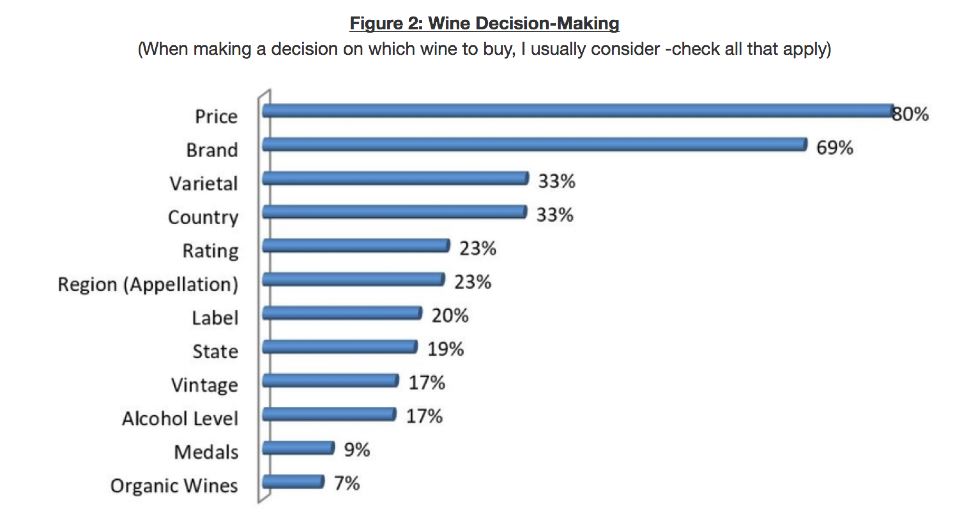 Some astute wine consumers look closely at the descriptors in a wine review and find it of paramount importance relative to the score. The description of the wine seems of greater usefulness especially if the reader can see “between the lines,” and understands certain words or phrases that the writer uses that are a tip-off indicating a special wine. Wine descriptions would seem to be of most value to well-informed wine consumers, while others less knowledgeable about wine look more to scores for guidance. As a writer and certified sommelier Katie Finn noted, “Scores act like life vests to shoppers drowning in a sea of options. The idea is that scores help people paralyzed with the fear of buying the ‘wrong’ wine.” David Morrison pens The Wine Gourd at www.winegourd.blogspot.com and points out, “Word descriptions of wine are frequently disparaged because it is often rather difficult to work out what all of this flowery language is supposed to mean. This dissatisfaction is one reason why wine-quality scores are popular because mathematics is supposed to make communication pedantically precise.” Justin Howard-Sneyd, a Master of Wine has said, “Describing wine is not an exact science; wine and taste are very personal and subjective. A wine that I think tastes of cherry, could taste totally different to someone else, so it’s no wonder that there is such a vast variety of language when it comes to wine descriptions.” Some descriptors are simply more useful than others. The charts below are from the 2013 Lathwaites Wine Survey in which those taking part said they were relatively well-informed on wine terminology. The first two charts show wine descriptors that are deemed “useful” and “least useful.” The third chart reveals research that shows 55% of consumers found descriptions of no help in understanding taste and 45% of the descriptions were considered “pompous.” Asked why the descriptions were not helpful, responses included finding them meaningless, bearing no relationship to a wine’s taste, pretentious and “a load of poppycock.”
The following charts were obtained from Daily News Fetch created by Wine Industry Insight, Lewis Perdue, Editor and Publisher, at www.industryinsight.com.
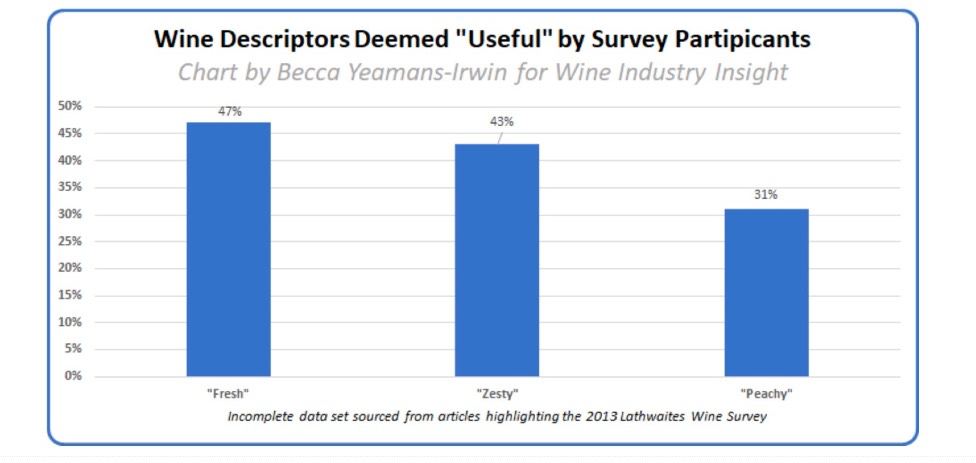
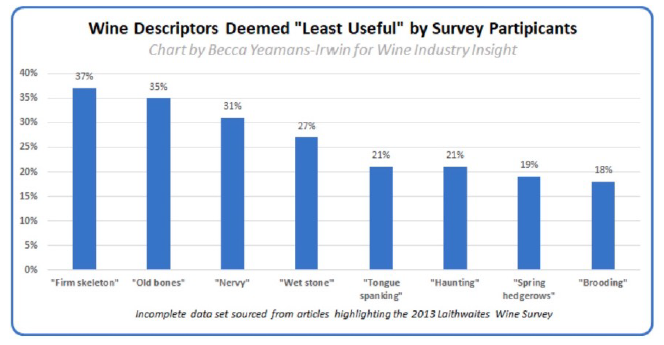
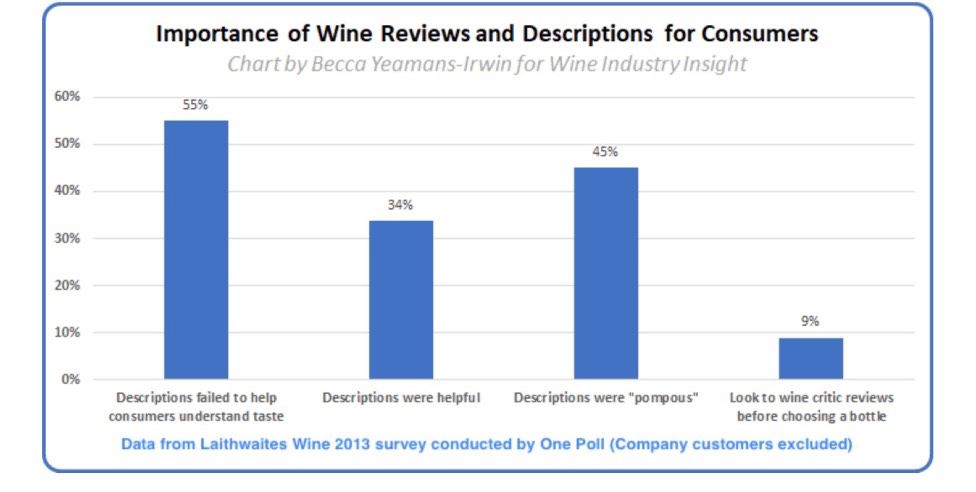 A common failing of wine scoring relates to wine reviews that don’t criticize wines or explain why they give a wine a low score. Here is a recent wine review from Wine Spectator for a wine that received a score of 87: “Wild sage, dark red cherry and turned earth show on the familiar nose of this bottling. The palate is even-handed with red fruit and chaparral flavors.” If you only read the description of the wine, what could you possibly discern about its quality or relate the description to the score? There is one drawback to professional wine reviews and not specifically to wine scoring that has to do with orthonasal versus retronasal perception of odors. Wine critics use a regime of sniffing, sipping and spitting but this orthonasal perception falls short of overall taste perception. Consumers swallow and experience an additional taste/smell sensation known as retronasal perception of odors whereby odors are perceived when they enter the nose through the pharynx in swallowing. A 2012 article in Physiology & Behavior, www.ncbi.nim.nih.gov/pubmed/22425641, on the retronasal perception of odors, pointed out that orthonasal and retronasal olfaction pathways convey two distinct sensory signals. The full perception of wine is based on the interaction between orthonasal and retronasal smell, taste and texture.
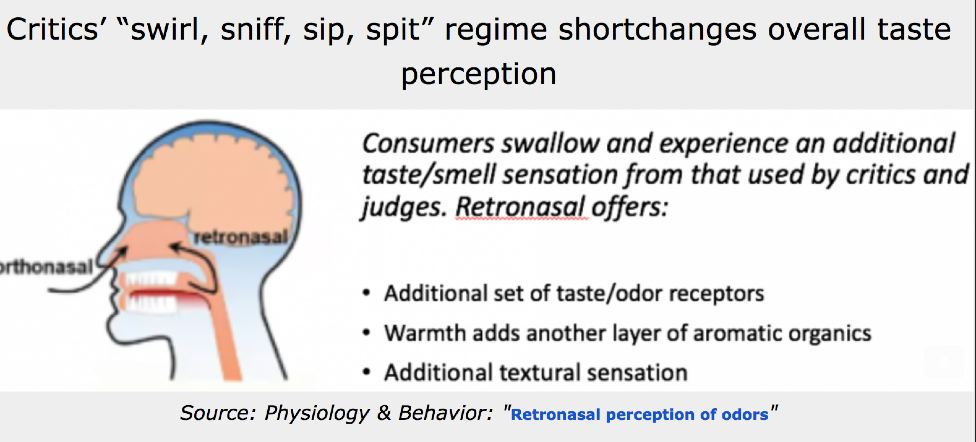 This is why I often taste wines in the morning with spitting and then re-taste some wines in the late afternoon with a swallow. I believe this is rarely done by wine tasting professionals. The 100-point scoring system clearly has many drawbacks but it has been and continues to be the main driving force that sells wine. “Amazing Scores for Our 2016 Vintage Wines” reads the marketing tagline for many wineries at this time of the year. The higher the score, the more retailers reference them, the more wineries promote them, and the more influential the review becomes. Discrepancies abound, however, with retailers known to quote scores for wines from a previous vintage or promote lofty scores that lack attribution. Scores are hollow numbers if not used in conjunction with the score assignor. Some sources quote scores from the Robert Parker Wine Advocate that the consumer may still attribute to Robert Parker, Jr., yet he is only one of nine reviewers for the Robert Parker Wine Advocate. I have come to the realization that the current wine rating system may have outlived its usefulness. I am not alone. Noted wine writer, Jamie Goode, said two years ago, “The 100-point scale is very compressed at the top end….and this scale is becoming so bunched at the top end that it is nearing the end of its useful life.” Maybe we have reached the point that scores are no longer of any value to the current generation of wine consumers in making purchasing decisions. Dwight Furrow, writing at www.3quarksdaily.com on the purpose of wine criticism recently noted, “I almost never read wine reviews prior to purchasing. I don’t need them for that purpose. I do read them after tasting the wine to learn more about what I’m tasting. But also I like to check my impressions against others who have tasted the wine because it teaches me something about my own palate and preferences.” Recently, the Chinese have launched a wine rating system based on Chinese tastes that is aimed at evaluating imported and domestically produced wines. As reported in November 2018 in The Drinks Business, www.thedrinksbusiness.com/2018/11/china-launches-its-own-wine-rating-system/, the Chinese wine rating system evaluates wines mainly based on color, aroma, palate and body using a scoring scale of 10 points. The rating system is said to reflect China’s unique culinary traditions and preferences. Apparently, a panel of judges consisting of members of the China Alcoholic Drinks Association (CADA) and the China Wine & Viticulture Technology Association will do the ratings that could lead to a national wine recommendation system. This critical wine reviewing system is not revolutionary in that the 10-point rating system is simply another numerically-based scoring program. George Vierra, who writes at www.georgevierrawinemaking.blogspot.com, described the Napa Valley College 25-Point Scorecard. This scoring system objectively analyzes wine's appearance, odor and taste for a total final score of a possible 25 points, and also includes a "Final Praises" section that includes further notes on wine style, ageing, food serving suggestions, price, value and where the wine can be purchased. My criticism of this scoring system is that it is but another variation of a mathematically-based scoring program and because it is based on 25 points, would only lead to challenges for the wine consumer to reconcile it with the 20-point and 100-point scoring systems. So what to do with a wine rating system that may have outlived its usefulness and is of little interest to the younger generation wine consumer?How can a new rating system be devised that won’t invalidate the 35 years of published ratings based on the 100-point system? Can we create a wine review with a noble calling, one that offers useful distinctions and criticism than one simply based on a highly subjective and personal numerical award? Can we corral all the important professional wine reviewers who are notoriously independent and have them use a standard review format that would be truly comparable?
Mining Oregon’s Willamette Valley for Good Pinot Noir Priced at or Less Than $30
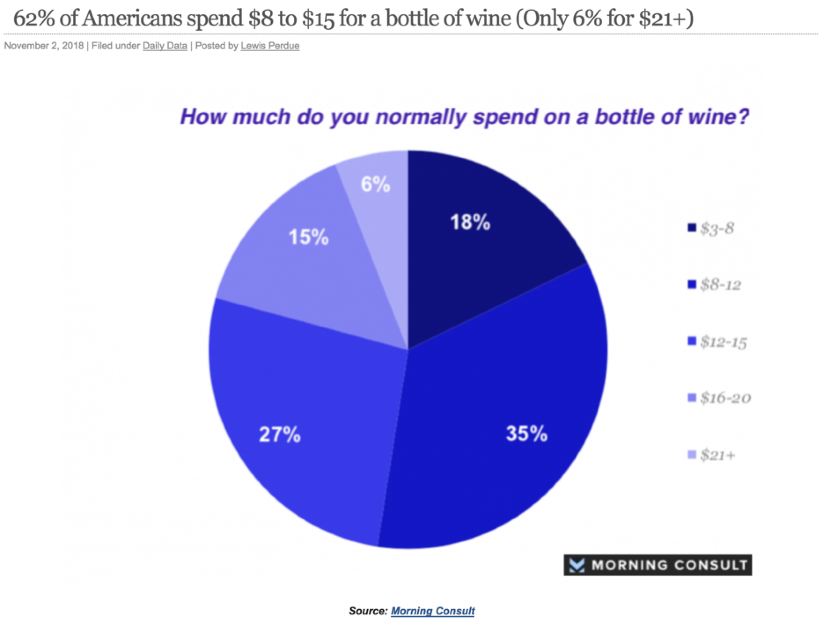 Among the top 25 Oregon wineries, the average retail bottle price is $26.04 for Willamette Valley AVA Pinot Noir, and $14.30 for an Oregon AVA Pinot Noir. This would indicate that there is still a plethora of affordable under $30 Pinot Noir in Oregon. Consumers should be alerted, however, that higher prices for Oregon wine may be coming. Oregon’s beer and wine taxes have not kept up with inflation and the state has not increased taxes on wine in 32 years. Oregon’s governor and the Oregon Health Authority are trying to raise $830 million in new sin taxes beginning in 2019 to cover the state’s rising Medicaid costs. Here are reviews of a representative sampling of currently released Willamette Valley designated and Oregon designated Pinot Noirs with an SRP of $30 or less from the 2015-2017 vintages. The 2015 vintage started early after a mild, wet winter. It was followed by a dry and hot summer (hottest on record) leading to picking in late August. September was the coldest September on record. This caused harvest to be drawn out until early October. 2016 was the year of “earliest ever.” A warm winter was followed by early bud break, early bloom, early veraison and early harvest -all early records. The 2017 vintage had a cooler than normal spring, but ideal weather after flowering creating a healthy fruit set. Summer was dry and hot (but not as hot as the preceding three vintages) leading to a “normal” Oregon harvest. Of the three vintages, I am partial to 2016.
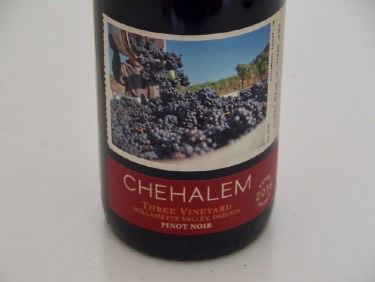 2016 Chehalem Three Vineyards Willamette Valley Pinot Noir 13.5% alc., pH 3.49, TA 0.62, 3,974 cases, $30, screw cap. Released April 2018. 100% estategrown: 20% Corral Creek Vineyard, 12% Stoller Vineyard and 68% Ridgecrest Vineyard. Harvest Brix 21.3º-25.2º. 100% de-stemmed, 4-8 days premaceration, 14-20 days total fermentation. Aged 11 months in French oak barrels, 29% new, 29% 1-year-old and 49% neutral. Crossflow filtered. · Moderately light garnet color in the glass. Nicely perfumed with aromas of cherry, dusty rose and baking spices. Light to mid weight in extraction, with juicy flavors of red cherry and berry complimented by a deft touch of oak. The wine aims to please with easygoing tannins and an aromatic finish of note. Always a dependable value in Willamette Valley Pinot Noir. Score: 91
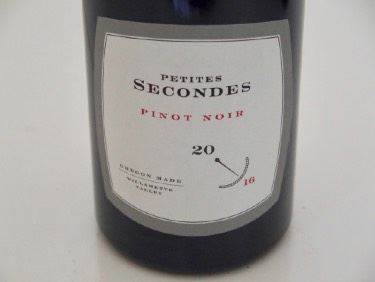 2016 Petites Secondes Willamette Valley Pinot Noir 14.1% alc., $25. Grown, produced and bottled by the Drouhin Family, Dayton, Oregon. · Moderate garnet color in the glass. Scents of black cherry, brown spices, toast and underbrush. Velvety in the mouth, with pleasing mid weight flavors of black cherry and savory herbs. Well-balanced, with a subtle oak backdrop and well-mannered tannins. A lovely wine for this price. Score: 91
2016 Beacon Hill Willamette Valley Pinot Noir 14.3% alc., 140 cases, $28, screw cap. A blend of grapes from estate owned, LIVE certified, La Colina and Beacon Hill vineyards. Aged 18 months in French oak barrels, 25% new. · Moderately dark garnet color in the glass. Inviting aromas of dark pie cherries, burnt tobacco and seasoned oak. Mid weight plus in extraction with mouth-filling ripe black fruits accented with a hint of smoky oak. Hearty for an Oregon Pinot Noir, but nicely balanced and welcoming. Score: 90
2016 Spindrift Willamette Valley Pinot Noir 14.1% alc., pH 3.55, TA 0.59, $22, screw cap. Sourced from seven small vineyards in the Willamette Valley, all dry farmed and many over 15 years of age. Clones are Pommard, Wädenswil, 115, 777 and 667. Aged in French oak barrels for over 10 months. · Moderately light garnet color in the glass. I was drawn into the glass in this wine by the aromas of cherry, strawberry, rose petal, and sandalwood. Light to mid weight in style, with a generous black cherry core of fruit that shows good vigor and intensity. A solid wine with a delightful cherry-embossed finish. Score: 90
 2017 Stoller Family Estate Dundee Hills Willamette Valley Pinot Noir 13.6% alc., pH 3.50, TA 0.58, 18,500 cases, $30, screw cap. A mosaic of Pinot Noir grapes from the estate vineyard including Pommard, Wädenswil, 777, 848, 667, 115 and 114 clones. Primarily native yeast fermentation before aging in French oak barrels, 15% new, 85% neutral, for almost a year. · Moderately light garnet color in the glass. Nicely composed perfume of cherry, rose petal and woodsy spices. Well-bred, middleweight flavors of dark red cherry and dark raspberry with an attractive savory herb thread in the background. Suave tannins and some cherry delight on the finish. Score: 90
2017 Chemistry Willamette Valley Pinot Noir 13.5% alc., pH 3.54, TA 0.56, $15, screw cap. Produced and bottled by Chehalem, Dayton, Oregon. Sourced from premier sites in the Willamette Valley. Aged in French oak barrels, 15% new, 85% neutral. · Moderately light garnet color in the glass. Aromas of red cranberry, baking spice and a hint of straw. Light to mid weight essence of juicy red cherry with a slightly confected tone. Silky in the mouth with easygoing tannins and a short, but pleasing finish. A friendly Pinot Noir. Score: 89
2015 Coeur de Terre Oregon Pinot Noir 13.8% alc., pH 3.64, TA 0.61, RS 0 g/L, 2,588 cases, $22, screw cap. 60% from Coeur de Terre Estate Vineyard. Harvest Brix 22.8º-24.2º Multiple clones including 113, 114, 115, 667, 777, Wädenswil and Coury. Soils range from sedimentary, to metamorphic to volcanic in origin. · Moderately light garnet color in the glass. Spiced cherry and fertile earth aromas lead to a middleweight styled wine offering cherry, plum and spice flavors backed by spirited acidity. T lip-smacking finish has good length. Score: 89
2017 Failla Willamette Valley Pinot Noir 13.3% alc., pH 3.55, TA 0.59, 2,000 cases, $28. Native fermentation, 30% whole cluster, aged 11 months on lees in French oak barrels, 15% new. Bottled unfined and unfiltered. · Moderately dark garnet color in the glass. Deep and intoxicating aromas of black cherry, black raspberry and dark rose petal. Full-bodied core of black cherry and boysenberry fruits offering an intense attack and expansive mouth feel. A modest oak accent is evident as is a savory herbal thread. Fruit-forward, with healthy tannins and a long, sweet, fruit-driven and somewhat astringent finish. The aggressive tannins need time or decanting to ameliorate. Score: 89
2017 Flaneur Willamette Valley Pinot Noir 13.7% alc., pH 3.65, TA 0.51, 2,170 cases, $28. 68% La Belle Promenade Vineyard (Chehalem Mountains) and 32% Flanerie Vineyard (Ribbon Ridge). Mixed Pinot Noir clones. The wine was fermented in a variety of stainless steel tanks and one large oak vessel. 36% whole cluster. Native yeast fermentation, and aged 11 months in French oak barrels, 11% new. · Moderately light garnet color in the glass. Initially, reserved aromas of red berry, red cherry and earthy flora unchanged over time in the glass. Mid weight flavors of dark red and purple berries backed by mild, silky tannins. The slightest oak is complimentary. This wine underwent a significant transformation when tasted the following day from a previously opened and re-corked bottle offering more giving fruit aromas, and more charm on the palate. Unusual for Willamette Valley AVA wines, but this one needs decanting. Score: 89
2016 Fullerton Three Otters Willamette Valley Pinot Noir 13.5% alc., pH 3.60, TA 0.53, $22, screw cap. Harvest Brix 22.9º-25.2º. Pommard, Wädenswil, 113, 114, 115, 667 and 777. Aged in French oak barrels, 5% new. · Moderately light ruby red color in the glass. Intriguing perfume of black cherry, nut oil, grilling spices and burnt tobacco. Very silky in the mouth with a stylish core of black cherry fruit underlain with a long kiss of oak. A satisfying wine with some finishing persistence. Score: 89
2015 Torii Mor Willamette Valley Pinot Noir 13.1% alc., pH 3.71, TA 0.58, RS 0.2 g/L, 7, 313 cases, $28, screw cap. Grapes sourced from 10 vineyards in the Willamette Valley including the Olson Estate Vineyard. 100% de-stemmed, fermented 13-19 days and aged 9 months in mostly French oak barrels with some Hungarian oak barrels, 20% new. Pommard, Wädenswil, 115, 777, 667, 114, 113 and Coury clones. · Light ruby red color in the glass. Lovely perfume of red cherry, strawberry and oak spice. Light to mid weight in style, featuring spiced cherry and berry flavors. Nicely balanced and elegantly composed. Score: 89
2015 Et Fille Willamette Valley Pinot Noir 12.1% alc., $28. A blend of several vineyards with sedimentary, volcanic and loess soils. Pommard, Wädenswil and Dijon 777 clones. · Moderately light garnet color in the glass. The scents of black cherry, pine and fertile earth lead to a middleweight crafted wine featuring flavors of dark red berries and blueberries. The wine has satisfying length in the mouth and finishes with juicy acidity. Score: 88
2017 Evolution Willamette Valley Pinot Noir 13.5% alc., RS 4 g/L, 21,100 cases, $20. Produced by Sokol Blosser Winery. 100% Willamette Valley AVA grapes. Fermented with proprietary yeasts and both fermented and aged in stainless steel. A small amount of oak staves was submerged in the stainless steel tanks for 2-3 months during aging to develop structure, enhance mouthfeel and stabilize the color. · Moderately light garnet color in the glass. Aromas of confected black cherry, cola, spice and sandalwood. This wine delivers a lot of black cherry flavor in a mid weight style with matched tannins. Slight oak and savory herbs ply the background. A good everyday Pinot. Score: 88
2015 H Wines Willamette Valley Pinot Noir 13.7% alc., pH 3.65, 814 cases, $26, screw cap. Elevee, Lazy River, Mt. Richmond, Bayliss-Bower, Le Chenaie, Bieze and Manuela vineyards. Aged 17 months in French oak barrels, 15% new. · Moderately light garnet color in the glass. The nose offers aromas of cherry, spice, weathered wood and matchstick. Sleek in the mouth, with mid weight flavors of black cherry, black raspberry and gracious oak. Gentle tannins and a short, satisfying finish. Score: 88
2016 Pike Road Willamette Valley Pinot Noir 13.5% alc., pH 3.60, TA 0.54, 8,163 cases, $20. screw cap. Offered by the Elk Cove family who have farmed in Oregon for five generations. This wine is produced from non-estate, family-owned vineyards in the Willamette Valley. Produced with the same care as Elk Cove Estate wines - hand-harvested grapes, sorted into small fermenters, aged 10 months in French oak barrels and bottled with state of the art equipment at the Elk Cove Estate. · Moderate garnet color in the glass. Shy, but pleasant aromas of blackberry and cassis. Mid weight plus in extraction, featuring flavors that echo the aromas. The wine packs a lot of fruit, but lacks a bit of zip and zing. The velvety texture is appealing, but the finish is brief. A fruit lovers style. Score: 88
2017 Samuel Robert Winery Vintner’s Reserve Willamette Valley Pinot Noir 13.0% alc., $16. This label is produced by Samuel and Bryn Coelho. Samuel is the son of celebrated Oregon winemakers Dave and Deolinda Coehlo. The wine is sold online in 6 and 12 packs but can be found at Total Wine & More. Post fermentation extended maceration. Aged in French oak barrels. · Light garnet color in the glass. Pleasing aromas of strawberry, red cherry, bark and earthy flora. Lighter weighted flavors of strawberry and red cherry. Silky in the mouth, with aggressive tannins that stick out on the dry, crisp and red cherry driven finish. Score: 87
2017 Stoller Family Estate Willamette Valley Pinot Noir 13.5% alc., pH 3.51, TA 0.57, 4,700 cases, $25, screw cap. Sourced from a collection of premier sites in the Willamette Valley and showcasing a myriad of Pinot Noir clones. Aged one year in French oak barrels, 15% new and 85% neutral. · Moderately light garnet color in the glass. Muted aromas of purple grape, spice and potpourri. Straightforward flavors of red and purple berry with innocuous tannins, integrated oak and a short finish. Fine, but nothing stands out. Score: 87
2017 Day Vin De Days Rouge Willamette Valley Pinot Noir 13.5% alc., sold out. 94% Pinot Noir, 3% Gamay Noir and 3% Cabernet Franc. Spontaneous co-fermentation, 50% whole cluster, stainless steel tank. · Moderately light ruby red color in the glass. Aromas of red berries, grape must, and red rose petal. Light in weight, with both red and purple fruit flavors lifted with spirited acidity. Somewhat drab, but pleasant, with minimal tannins and a short, thin, dry finish. Less likable over time. Score: 86
Pisoni Vineyard Pinot Noir: An Iconic Wine Unlike Any OtherThere are but a few iconic California Pinot Noirs. Rochioli West Block, Hanzell Ambassador’s 1953 Vineyard, Calera Jensen, and Mount Eden to name some of the few. Pisoni Vineyard Estate Pinot Noir, known as “Pisoni, Pisoni,” is one of the elite members of this fraternity. Gary Pisoni planted his first five acres of own-rooted vines in virgin soil at 1,300 feet elevation in the Santa Lucia Highlands in 1982. The original vines are rumored to be suitcase cuttings from a famous Domaine in Vosne-Romanée now referred to as the Pisoni selection or “clone.” Pisoni Vineyard fruit quickly became highly prized in California, and it is not an overstatement to say Pisoni Vineyard put Santa Lucia Highlands on the map. The Pisoni Vineyard is one of the highest-elevation vineyards in the Santa Lucia Highlands. 36 acres are planted with 30 individually farmed blocks. The soil is decomposed granite with high amounts of schist and quartz. There is a significant cooling maritime influence that includes fog. The vines are sustainably hand-farmed. Gary’s sons Jeff (the winemaker) and Mark (the winegrower) created the Pisoni label, releasing the first Pisoni Estate Vineyard Pinot Noir in 1998. The Pisoni family essentially produces one Pinot Noir each year under this label. The wine is a blend of several blocks on the estate. Total production ranges from 500 to 800 cases annually, depending on yield. (Left to right - Jeff, Gary and Mark).
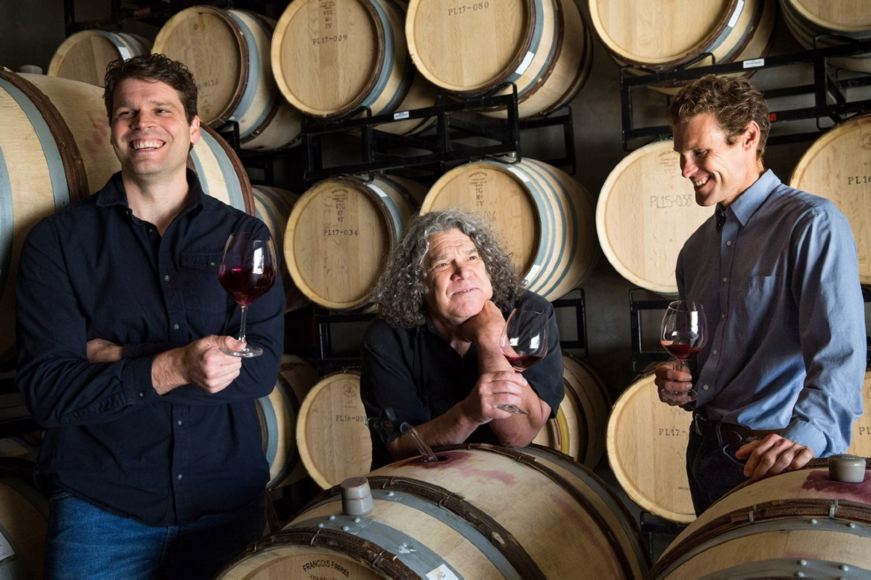 A Pisoni Vineyard Estate Chardonnay, produced from vines that include initial plantings dating to 1982 and some blocks planted in 1999, is also offered. I rarely write about a single wine, but the 2016 Pisoni Estate Pinot Noir deserves the honor. In 2016, there was limited rainfall so that roots had to dig deep for moisture. The result was bold tannins and intensity that required careful managing. The conditions in 2016 necessitated that the Pisonis drop a considerable amount of fruit so as to not overly stress the vines. The resulting yields were only about two tons per acre. After harvest, Jeff’s top priority was watching the tannin evolution during fermentation. The fruit had robust structure, so punch downs were restricted to the beginning and middle of the process with less at the end. The wine was produced at a custom crush facility in Rohnert Park, CA. Pisoni Estate Pinot Noir and Chardonnay are only sold by allocation to the winery’s mailing list on an annual basis. Visit www.pisonivineyards.com. Since the demand for Pisoni Estate wines exceeds production, new applicants to the winery’s mailing list may have to wait for a few vintages before being offered wine. I wish more Pinot lovers could taste this wine. Pisoni Estate wines are sent in a classy wood box encased in black styrofoam with each bottle individually wrapped in tissue. The Pinot Noir is typically rich and powerful, but with well-tamed tannins. The wine benefits from decanting for 30-60 minutes after opening. I reported on a vertical tasting of Pisoni Estate Pinot Noir, 2004-2014, in 2017: www.princeofpinot.com/article/1903/.
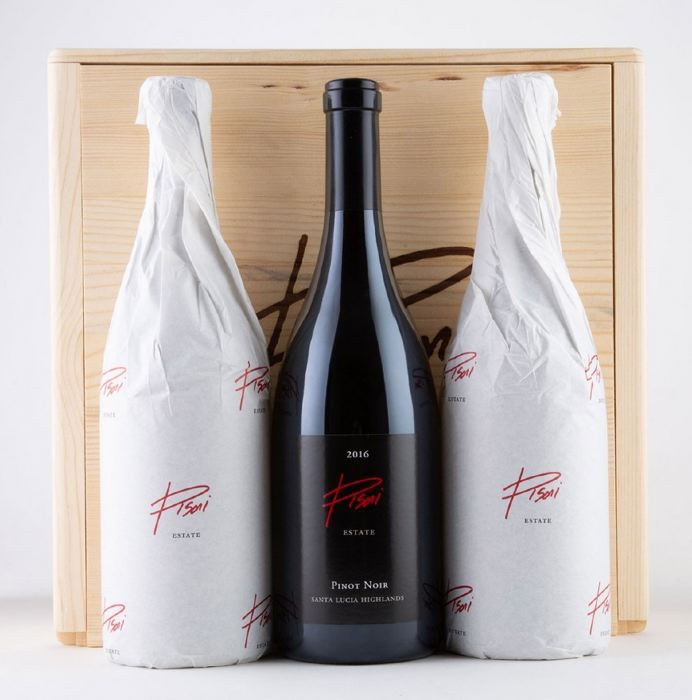
2016 Pisoni Estate Santa Lucia Highlands Pinot Noir 14.1% alc., 615 cases, $90. Released September 2018. Native yeast fermentation, 100% de-stemmed, aged 11 months in French oak barrels, 63% new. Bottled unfined and unfiltered. · Dark garnet color in the glass. Lovely aromas of boysenberry, blackberry, complimentary spice and tobacco. Fullbodied with remarkable dark cherry and berry fruit intensity. Luscious and dreamy on the palate with corralled, mellow tannins, and a deft touch of spicy oak. A bold expression of Pinot Noir yet displaying lovable freshness. A distinctive wine that has no peer. The wine gains countenance and class when tasted from an opened bottle several hours later. Score: 96
Merry Edwards: The Reine De Pinot
When Merry entered graduate school at UC Davis in the early 1970s, she found that the University did not fully back her entry into an industry and profession that was primarily male-dominated. Taking exception to the favoritism within the Department of Viticulture and Enology, she challenged the reluctance to allow all students regardless of sex equal access to employment opportunities. Her Master’s thesis made waves. She created a method for analyzing lead in wine and did a broad study of California vintages, discovering that lead migrated into wine from lead capsules that were in widespread use. Her results were suppressed for an entire year along with an inability to complete her thesis. The eventual repercussion was the termination of lead capsule use in the wine industry. Merry was hired to succeed Peter Graff as winemaker at Mount Eden Vineyards in 1974 and she crafted some remarkable Pinot Noir wines during her short tenure there (1974-1976). Her career at Mount Eden was remarkable because there were few winemaking jobs offered to women at the time and only a handful of notable Pinot Noir wines were being produced in California. As points of historical reference, Joe Swan released his first Pinot Noir in 1973, Davis Bynum bottled his first Rochioli Vineyard Russian River Valley Pinot Noir in 1972, and Tom Dehlinger, Forrest Tanzer at Iron Horse and Marimar Torres were starting their own Pinot Noir programs in the Russian River Valley in the mid-1970s. After leaving Mount Eden in 1977, Merry led the emergence and national prominence of Matanzas Creek Winery in Bennett Valley. She soon had her own label, Merry Vintners in the 1980s, and involvement with another winery, Domaine Laurier, both of which failed financially. Through the 1990s she consulted for numerous wineries including Liparita, Fritz, Lambert Bridge, B.R. Cohn and Pellegrini Family Vineyards. A life-changing moment in Merry’s professional career came in 1997 when she co-founded a business venture with friends, founding partner Bill Bourke, and her husband and partner Ken Coopersmith. They launched Merry Edwards Wines to produce Pinot Noir from select vineyards in the Russian River Valley and Sonoma Coast, and, for the first time, her own vineyards. She says, “I had always wanted to make wine from the ground up. If you have to buy grapes and try to make great wines out of purchased grapes, it’s a lot harder than if you control your destiny and can make the wine from the ground up.” The first release under the Merry Edwards label was 2,250 cases of Russian River Valley Pinot Noir, including some from Olivet Lane Vineyard, the winery’s first single-vineyard offering. Merry owned a 24-acre fruit orchard in the southern Russian River Valley (Sebastopol Hills) and the founding of Merry Edwards Wines allowed her to follow her dream and plant her own vineyard. The Meredith Estate Vineyard was planted at the former orchard in 1998 to Pinot Noir clones 115, 667, 777, Mt Eden and a Swan selection (photo of Meredith Estate Vineyard below). In 1999, Merry created Klopp Ranch from Ted Klopp’s vineyard planted to clones selected by Merry. Also in 1999, the first of five vintages of Pinot Noir from Windsor Gardens Vineyard were produced. This beautiful site was bulldozed in 2004 due to urban sprawl.
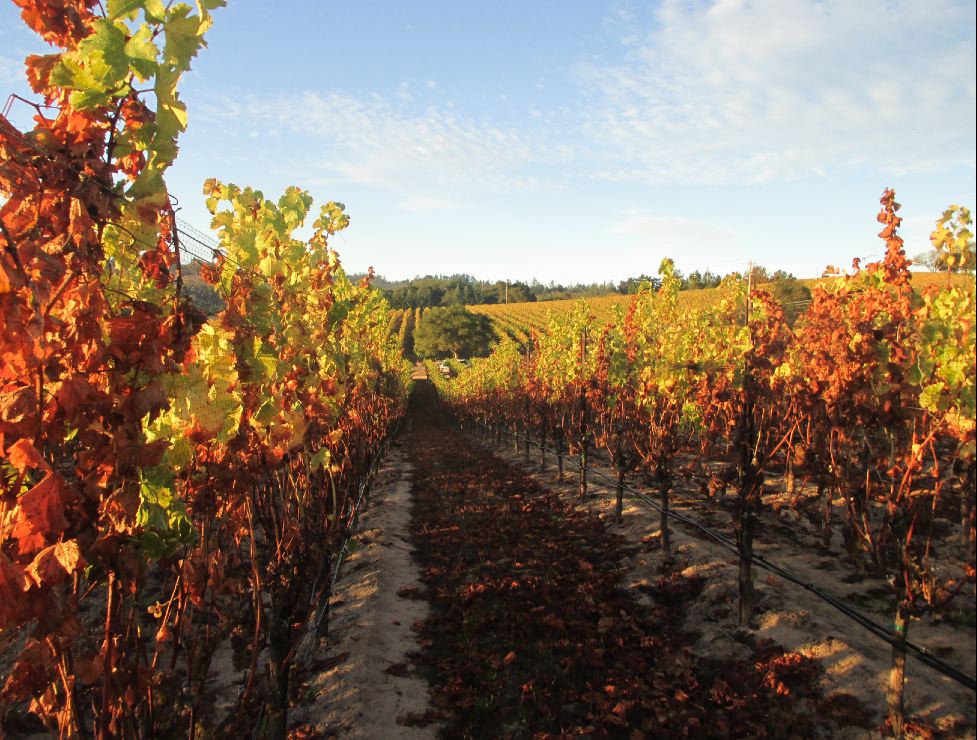 A second estate vineyard, the 9.5-acre Coopersmith Vineyard, was planted in Sebastopol near the intersection of Gravenstein Road and Graton Road in 2001 to the Mt Eden clone (UCD 37) and an “828” selection sourced from Oregon’s Archery Summit. The “828” did not perform well and was subsequently budded over to other clones. After many years of working at other wineries, Merry built her own specially-designed winery on the same property in 2006-2007 along with a tasting venue. In 2006, a third estate vineyard, Georganne Vineyard, was added to the Merry Edwards family. In 2012, Ken and Merry purchased a property in the Sebastopol Hills to plant as Richaven Vineyard. They also bought Maefield Vineyard in Forestville, now a Sauvignon Blanc vineyard and home to the winery’s guesthouse. Warren’s Hill Vineyard was developed in Green Valley in 2015. Additional Sauvignon Blanc acreage has been established at Meredith Estate Vineyard. As of the 2017 harvest, estate vineyards make up 60% of the winery’s overall production, with the number still growing. All estate vineyards are sustainably farmed. John Haeger and others have pointed out that Merry was one of the first California winemakers to value clonal selection, spent time in Burgundy to observe clonal research, and was the first lecturer on clonal selection at UC Davis. Her pioneering clonal research while at Mount Eden led to the now widely-planted Mount Eden clone (UCD 37). Merry was inducted into the 2013 Vintners Hall of Fame. Only two other women have been so honored, American grape geneticist Carole Meredith and winemaker Zelma Long. She has been a champion of women winemakers and a spokesperson against discrimination in the winemaking field. She also has been a prominent promoter of Sonoma County and its wines, particularly the Pinot Noir wines of the Russian River Valley. Merry Edwards Winery is one of the few California wineries to produce both Pinot Noir and Sauvignon Blanc. Her extensive list of appellation and vineyard-designated Pinot Noirs are in great demand from both consumers and restauranteurs. Year in and year out, Merry Edwards wines are one of the top ten most popular restaurant wine list brands. Merry’s favored style of Pinot Noir includes lavish, ripe, dark fruit flavors, powerful concentration, firm tannins, and lavish oak for aging (at least 60% new French oak). She uses a generous percentage of whole clusters. Acid additions are standard since grapes are picked very ripe. These are bold, unapologetic expressions of Pinot Noir, a style favored by many consumers. Her Sauvignon Blanc style was honed over several years at Matanzas Creek and today is considered one of the best of this varietal offered in California. Merry started crafting Sauvignon Blanc under the Merry Edwards label to have a white wine to pour at winemaker dinners. The wine became so popular that it now makes up nearly 50% of the winery’s total production. Merry has been one of the few California vintners to produce both Pinot Noir and Sauvignon Blanc. The latest fall 2018 releases from Merry Edwards reviewed here represent the winery’s 20th vintage and Merry’s 45th harvest as a California winemaker. In October 2018, it was announced that Merry had elevated Associate Winemaker Heidi von der Mehden to the position of Winemaker. Heidi grew up in wine country and received a degree in chemistry from Santa Clara University in 1997 - the same year Merry Edwards Winery was founded. Heidi has spent a total of 18 years in the wine industry including work as Winemaker for Arrowood, Assistant Winemaker at Mauritson and experience at Kenwood Vineyards. She came to Merry Edwards in 2015, working closely alongside Merry. Heidi made the new Merry Edwards single-vineyard designate Bucher Vineyard Pinot Noir, starting in 2016 and participated in creating Vintage 20, a cuvée celebrating the 20th anniversary of the Merry Edwards brand in 2017. Heidi and Merry are pictured below.
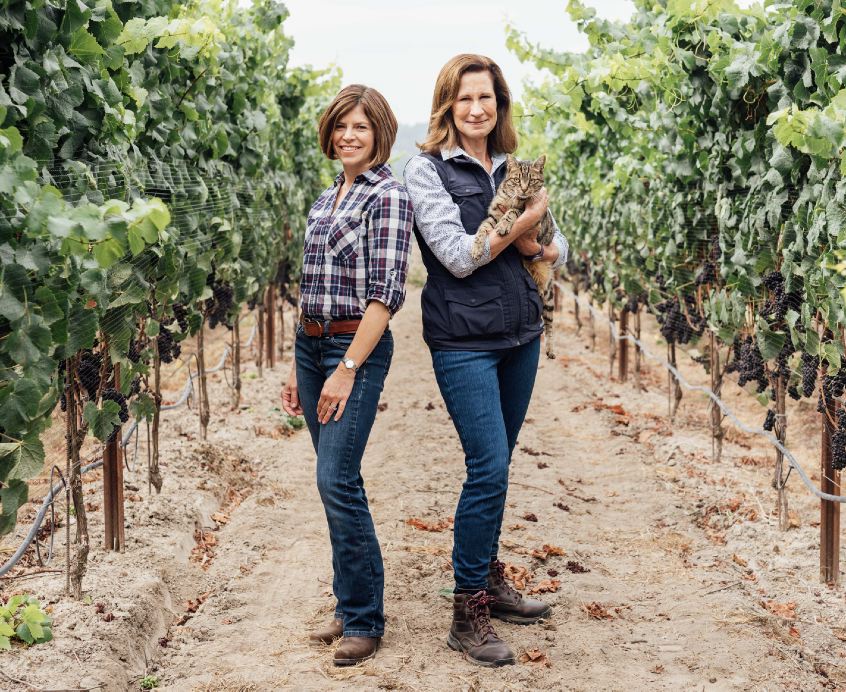 Merry Edwards wines are sold through a mailing list, online at www.merryedwards.com, and through retail and restaurant distribution. Tasting is available by appointment at the winery located at 2959 Gravenstein (116) Highway North in Sebastopol.
2016 Merry Edwards Sonoma Coast Pinot Noir 14.3% alc., 2,500 cases, $48. A blend of eight lots of wine grown at five distinctive vineyard sites. Both California and Burgundy clones. · Moderate garnet color in the glass. An arsenal of aromas including ripe, dark fruits, violets, baking spices, oak cask and vanilla. Plenty of stuffing in a mid weight plus style, offering flavors of sweet, earthen, dark red and purple berry fruits with toasty oak in the background. The fruit is not as ripe and sappy as found in other Pinot Noirs in the 2016 lineup. Forward drinking and juicy, with modest tannins and some finishing persistence. Score: 91
2016 Merry Edwards Klopp Ranch Russian River Valley Pinot Noir 14.5% alc., 664 cases, $66. This vineyard overlooks the western edge of the Laguna de Santa Rosa in the middle of the Russian River Valley. Soils are classic Goldridge. Clones are Pommard, 115, 667, 777 and a Swan selection. · Moderately dark garnet color in the glass. Aromas of black fruits, cola, forest and a hint of vanilla. Mid weight plus in concentration, featuring a wave of blackberry, cassis and spice flavors, framed by substantial, but gracious tannins. and complimented by toasty oak in the background. Overall, the balance is commendable and the powerfully succulent finish leaves a good impression. Score: 93
2016 Merry Edwards Meredith Estate Russian River Valley Pinot Noir 14.5% alc., 1,375 cases, $68. Clone 667 forms the foundation of this wine. UCD 37, 777 and a Swan selection round out the blend. · Moderately dark garnet color in the glass. Pleasing aromas of black raspberry, blackberry, sawdust and nutty oak. A glorious attack of lavish black fruits draws attention. Intense and brooding, even over time in the glass. Harmonious tannins create a sleek and satisfying texture. The glorious finish (and I have this underlined in my notes) concludes with waves of ripe fruit. Bombastic! Score: 94
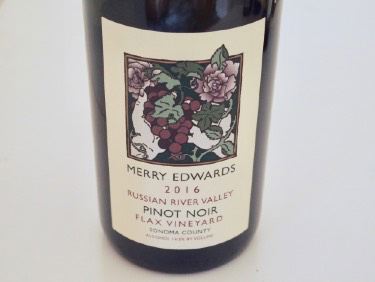 2016 Merry Edwards Flax Vineyard Russian River Valley Pinot Noir 14.5% alc., 580 cases, $63. This vineyard is located on Westside Road. 100% Pommard clone. · Moderate garnet color in the glass. Assertive aromas of black cherry, bola and underbrush. Delicious core of ripe black cherry fruit backed by substantial but not intrusive tannins. More appealing elegance compared to other 2016 Pinot Noirs reviewed here. The finish is remarkable for its length and the display of haunting black cherry goodness. Even better when tasted several hours later from a previously opened and re-corked bottle when more spice accent came out to enhance the regal fruit. Score: 95
2016 Merry Edwards Vintage 20 Russian River Valley Pinot Noir 14.5% alc., 222 cases, $120. Commemorates the 20th anniversary of Merry’s eponymous brand. A selection of the most luscious barrels from each of the winery’s estate vineyards: Coopersmith, Georganne, Meredith Estate and Warrens’ Hill. It is primarily composed of UCD 37 clone, with a small percentage of 667 and the progeny of Windsor Gardens. · Moderately dark garnet color in the glass. This is a super ripe, sweet, compote-like, bold wine with aromas of crushed dark berries, blackberry reduction, leather saddle and Eastern spices. Intensely flavored boysenberry and blackberry fruits are framed by husky tannins that envelope the fruit. There is plenty of lavish, vanilla-laced oak infusion. The finish is extremely long and generously endowed with purple fruits but is somewhat astringent. The wine did not show much change when tasted the following day from a previously opened and re-corked bottle. This reserve styled wine definitely makes a bold statement with its massive arsenal of super ripe, fruit-driven sauciness and thick oak flavors, but it is too over-the-top for my tastes. Score: 90
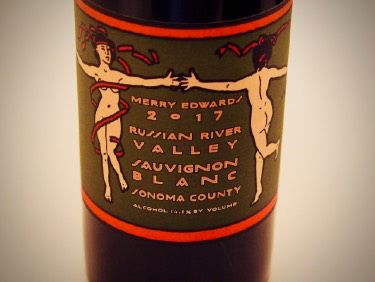 2017 Merry Edwards Russian River Valley Sauvignon Blanc 14.1% alc.,10,500 cases, $36. The key component in this wine is the highly floral Sauvignon Musqué selection from Sancerre, which comprises one-third of the blend. The Shenandoah clone balances this out with its classic herbal and grassy character. For the first time, a substantial proportion of grapes were harvested from the winery’s young estate vineyards (nearly 30 per cent). Fermented and aged in French oak barrels, 18% new, with biweekly lees stirring. · Moderately light golden yellow color in the glass. Terrific nose, offering a perfume of white rose, pear, white peach, pineapple, spice and a hint of warm straw. Delectable flavors echo the nose with Sauvignon Blanc’s signature grassiness in the background. Slightly creamy in texture with gracious acidity and a floral-embossed finish. This wine is consistently superb in every vintage. My alltime favorite California Sauvignon Blanc it is the oneI buy and choose to drink every vintage. Score: 94
Recently Tasted California Pinot Noir & Chardonnay
Briceland Vineyards, Redway (Humboldt County), CAOwner and winemaker Andrew Morris works off the beaten Pinot trail in the tiny town of Redway in southern Humboldt County. The winery was first established 33 years ago by winemaker Joe Collins who turned over ownership to Andrew in 2014. The wines have won many medals at wine competitions and represent terrific values.
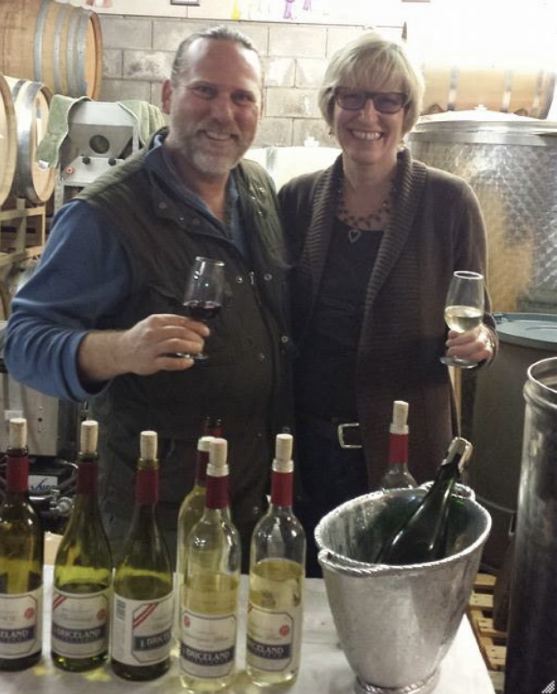 Tasting and tours of the winery can be arranged by appointment. You must contact the winery by email or phone to order wines. Visit www.bricelandvineyards.com.
2015 Briceland Vineyards Humboldt County Pinot Noir 12.9% alc., 163 cases, $32. · Light ruby red color in the glass. Pleasant aromas of red cherry and berry and earthy flora. Light in weight, offering juicy flavors of red cherry, raspberry and cranberry framed by gentile tannins. Elegant and refined, with some staying power on the finish. A very good table wine. Score: 89
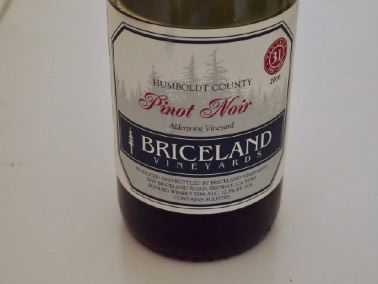 2016 Briceland Vineyards Alderpoint Vineyard Humboldt County Pinot Noir 12.3% alc., 162 cases, $35. Vineyard planted in 1991 in consultation with Briceland’s founding winemaker Joe Collins. · Moderately light garnet color in the glass. Earthy aromas of blackest cherry and blackberry fruits. Engaging mid weight flavors of black cherry and purple berry with a touch of baking spice. The soothing texture results from felty tannins. Some of the fruit fragrance returns to haunt the appealing finish. Score: 92
2017 Briceland Vineyards Phelps Vineyard Humboldt County Chardonnay 13.6% alc., 173 cases, $26. · Moderately light golden yellow color with a little spritz in the glass. Aromas of lemon-lime, pear, sea breeze and grassiness. A crisp, clean style with redeeming acidity, offering flavors of lemon-lime, green apple, lemon creme and vanilla. A spry wine that aims to please. Score: 92
Foursight Wines, Boonville, CAA family owned winery producing Pinot Noir from the estate Charles Vineyard. The winery was launched in 2007 by Bill and Nancy Charles, daughter Kristy Charles and her winemaker spouse Joseph Webb. The vineyard was planted in 2001, and a winery and tasting room opened in 2009 on the vineyard property on Highway 128 in the Anderson Valley. Visit www.foursightwines.com.
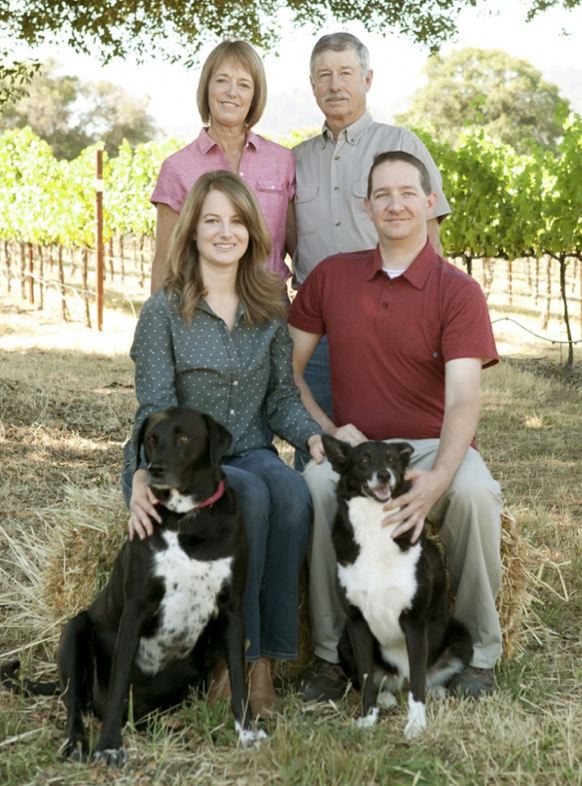 All wines are vinified with wild yeast (no yeast inoculations have ever been done at the winery) and bottled unfined and unfiltered. The back labels list all the ingredients in the wine including grapes, tartaric acid and sulfur dioxide, and are suitable for vegetarians or vegans.
2015 Foursight Charles Vineyard ZERØ Anderson Valley Pinot Noir 14.0% alc., pH 3.64, TA 0.61, 320 cases, $39. Released July 2018. A blend of estate clones 114, 115, 777 and Pommard 5. Fermented with 20% whole clusters.. Pressed in a gentle, Champagne-style basket press. Aged in second year and older French oak barrels (zero new oak). · Light ruby red color in the glass. Perfumed and sensuous with flowing red cherry and red berry fruit aromas. Light to mid weight in concentration, featuring regal dark red fruits that make an impression on the mid palate and last with vigor through the refreshing finish. A savory herb thread adds interest. Easy to drink, with gossamer tannins. Score: 92
2015 Foursight Charles Vineyard Anderson Valley Pinot Noir 14.0% alc., pH 3.76, TA 0.60, 300 cases, $48. Released July 2018. Clones 777, 114, 115 and Pommard 5. 20% whole clusters, native yeast and native malolactic fermentations. Aged in French oak barrels, 33.3% new. · Moderately light garnet color in the glass. Appealing aromas of black cherry compote, dark red raspberry and dusty earth. The deeply flavored dark cherry core is expansive in the mouth and forthright on the finish. A little oak-driven barbecue spice and toast adds interest. The tannins are immersed and the juicy acidity adds good lift. A veritable cherry jubilee with a delectable finish. Score: 93
2016 Foursight Charles Vineyard Clone 05 Anderson Valley Pinot Noir 13.9% alc., pH 3.75, TA 0.60, 262 cases, 125 cases, $54. Released July 2018. 25% whole clusters, native yeast fermentation. Aged in French oak barrels, 43% new. Five favorite barrels. · Moderately light ruby red color in the glass. Robust aromas of Bing cherry, rose petal and red gum drops. Delicious core of fresh cherry fruit with accents of spice and anise. Juicy acidity, with fine-grain tannins and a noticeably long finish. A real cherry delight. Score: 93
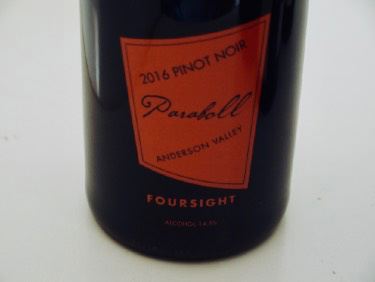 2016 Foursight Paraboll Charles Vineyard Anderson Valley Pinot Noir 14.5% alc., pH 3.77, TA 0.59, 200 cases, $60. Released July 2018. The name of this wine is derived from the Boontling language unique to Anderson Valley: “Para” is a term for a deep, cherry red color and “Ball” or “Bahl” means “of excellent quality.” Put together, Paraboll means “a great red.” The wine is a homage to the Londer family where the name originated and to a heritage language of Anderson Valley. This wine is produced with a different ripening schedule and barrel regimen. The grapes were given additional hang time before harvest for a darker fruit profile and then aged in 50% new French oak barrels for 11 month with heavy and medium-plus toast barrels. It is a homage to the Londer family where the name originated and to a heritage language of Anderson Valley. · Moderate garnet color in the glass. Vivid aromas of cherry, dark chocolate and cigar box. Virile, well-ripened black raspberry, black cherry and blackberry fruit flavors fill the mouth with pleasure. The weighty sap is buttressed by gutsy tannins that compliment rather than intrude. The comfortable texture provides appeal. A little rustic and earthy in a good way creating an individuality distinct from the other expressions of the Charles Vineyard. Score: 94
Maryetta Wines, Boonville, CAOwner Phil Jones founded this winery focusing on Pinot Noir from Mendocino County. Winemaker Damon Bailey crafts the wines at Venge in Napa Valley, but the winery has a tasting venue in the historic Live Oak building in Boonville in Anderson Valley.
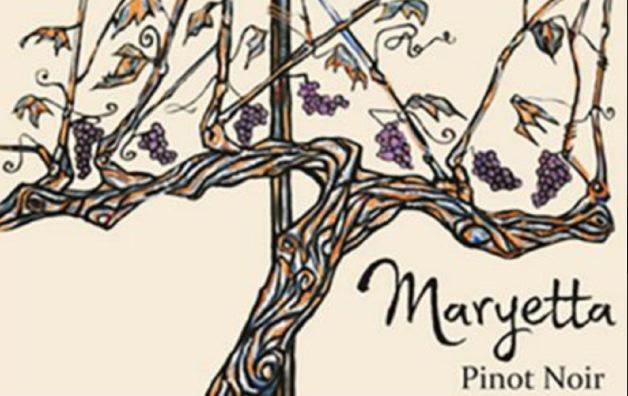
2016 Maryetta Wines Nash Mill Vineyard Anderson Valley Pinot Noir 13.2% alc., ph 3.68, 69 cases, $40. Farming by Jason Drew and Vineyards Logistics. Winemaking by Damon Bailey and Venge Vineyards crew. Clones 667 and 115. Whole berry native fermentation. Aged on the lees in French oak barrels, 2 to 5-year-old, for 11 months. Bottled unfiltered, without Velcorin. · Moderately light garnet color in the glass. Nicely scented, with aromas of fresh cherry, raspberry and oak spice. Fresh, wholesome and giving, with a mid weight core of black cherry fruit. Slightly earthy, with a satin texture and some finishing purpose. Score: 91
2016 Maryetta Wines “Black Hoop” Anderson Valley Pinot Noir 12.8% alc., pH 3.71, 140 cases, $32. Farming by Jason Drew and Vineyards Logistics. Winemaking by Damon Bailey and Venge Vineyards crew. 50% Valenti Ranch and 50% Nash Mill Vineyard. Clones “828,” Pommard, 667, 115 and a Rochioli selection. Whole berry native fermentation. Aged 11 months on the lees in French oak barrels, 2 to 5-year-old. Bottled unfiltered, without Velcorin. · Moderate garnet color in the glass. Nicely perfumed with aromas of red cherry, spice, sandalwood and earthy flora. Impressive balance with buried tannins and a soothingly sleek mouth feel, offering discreetly concentrated red cherry and raspberry fruit flavors. The oak is deftly managed and the cherry-fueled finish is a delight. Score: 92
2016 Maryetta Wines Valenti Ranch Mendocino Ridge Pinot Noir 12.7% alc., ph 3.59, 67 cases, $45. Clones are 667, “828,” Pommard, and a Rochioli selection. Whole berry native fermentation. Aged 11 months on the lees in French oak barrels, 2 to 5-year-old. Bottled unfiltered, without Velcorin. · Moderately light garnet color in the glass. Aromas of oak-kissed cherry and burnt tobacco. Flavors of red cherry and berry, spice and delicate oak. Juicy, with charming crispness and freshness. Modest tannins and some finishing length. Score: 91
2017 Maryetta Wines Valenti Ranch Mendocino Ridge Pinot Noir 13.9% alc., pH 3.73, 92 cases, $45. Vineyard farmed by Jason Drew and Vineyards Logistics. Clones are Pommard, “828,” and a Rochioli selection. Whole berry native fermentation. Aged on the lees for 11 months in French oak barrels, 2 to 5-year-old. Bottled unfiltered, without Velcorin. · Light garnet color in the glass. Initial aromas are skewed more toward wood, earth and crusty bread with little purple berry charm. A little more ripeness and concentration than the 2016 version of this wine, with more tannin and more oak infusion, and overall a little less charming. The finish is mildly astringent. The aromatics arrived with more fruit and spice when tasted the following day from a previously opened and re-corked bottle. Score: 90
Migration Wines, Hopland, CAWinemaker Dana Epperson, a third generation Sonoman, has been making Pinot Noir her entire professional life (photo below). She says, “I love Pinot Noir. It can be such a complex wine. A great Pinot can be transcendent when it comes from the right vineyard, farmed the right way, with the perfect climate, clones and soils.” She is one of the precious few women making Pinot Noir in California today.
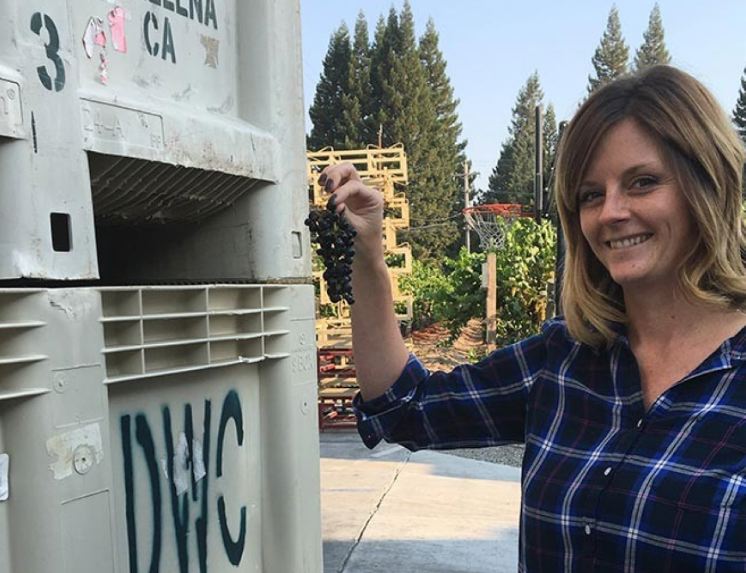 Her passion shows through in these excellent wines. These vineyard-designated wines are the best of the best, in that they are produced from carefully selected lots and barrels. Because these four wines are vinified identically, except for small differences in cooperage toast levels and timing of pressing, they reflect where they came from. Migration Pinot Noir and Chardonnay are part of the Duckhorn Wine Company. The label was originally a second for Goldeneye. The wines are sold on the website at www.migrationwines.com. tasting is available (appointments preferred) at Goldeneye Winery in Anderson Valley.
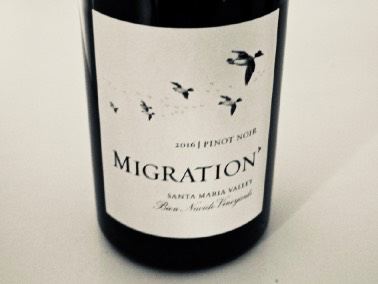 2016 Migration Bien Nacido Vineyard Santa Maria Valley Pinot Noir 13.9% alc., $70. Aged 10 months in French oak barrels, 40% new, 60% neutral. · Moderately dark garnet color in the glass. Vigorous aromas of black cherry, baking spice, black tea and cigar hold up over time in the glass. An excellent charge of sumptuous black cherry fruit is complimented by a hint of oak and an earthiness. Impeccably balanced with a redeeming cut of acidity, and an intense, black cherry-fueled finish. Pretty much all you can ask for in a Pinot Noir. Score: 94
2016 Migration Drum Canyon Vineyard Sta. Rita Hills Pinot Noir 13.9% alc., $70. Vineyard planted in 2003 and farmed by the Dierberg family. Aged 10 months in French oak barrels, 40% new and 60% neutral. · Moderate garnet color in the glass. The nose is “down and dirty,” offering aromas of fertile earth and clay with a hint of blackish fruit. More savory than fruity in a mid weight style, with flavors of red and black cherry and red and black raspberry accented with botanical, tar and black tea notes. Nicely balanced, with good acidity and some finishing length and boldness. Score: 91
2016 Migration Dutton Ranch Russian River Valley Pinot Noir 13.9% alc., $70. Sourced from two cool vineyards in the Green Valley sub appellation of the Russian River Valley. Aged 10 months in French oak barrels, 40% new, 60% neutral. · Moderate garnet color in the glass. Aromas of dusty black cherry, raspberry, vanilla and striking spice. Black cherry-driven in a middleweight style with a compliment of Asian spices. Satisfying harmony, with reserved tannins, engaging acidity, and a lovely spiced cherry finish. Score: 93
2016 Migration Running Creek Vineyard Russian River Valley Pinot Noir 14.5% alc., $70. Aged 10 months in French oak barrels, 40% new, 60% neutral. · Moderately dark garnet color in the glass. Soaring aromas of bing cherry, cola and red rose petal. Packed with voluptuous black cherry and blackberry fruit in a mid weight plus style, yet sleek and welcoming. Balanced tannins hold the prodigious fruit in check, and the overall impression is one of polish. Clearly, the ripest fruited of the four wines tasted in this vintage. Score: 92
Sea Smoke Cellars, Lompoc, CASea Smoke is now approaching its 20-year anniversary. As the vineyard has slowly evolved with each new vintage, so has the winemaking team’s approach to crafting the wines. This includes harvesting the grapes at lower Brix levels, gradually reducing the amount of new oak used during aging, refining the cooperage selection, and reducing the amount of sulfur used for the Chardonnay. The name, “Sea Smoke,” refers to the Pacific Ocean marine layer of fog that covers the Pinot Noir and Chardonnay hillside Sea Smoke Estate Vineyard.
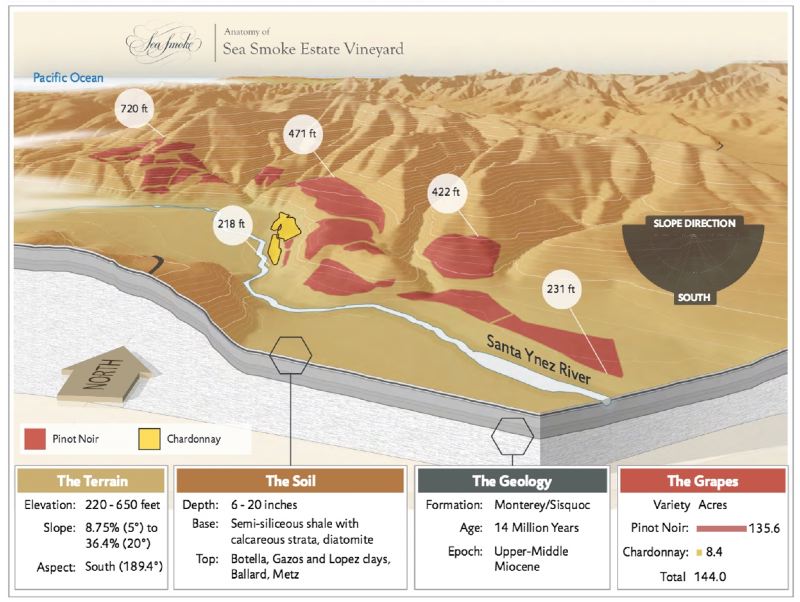 This winery does not buy grapes or sell grapes. There is no public tasting room and no club or events, so winemaker Don Schroeder and his team can focus all their energy on the vineyard and winemaking. This includes labor-intensive farming required to earn biodynamic and organic certifications. To join the “the list,” visit www.seasmoke.com.
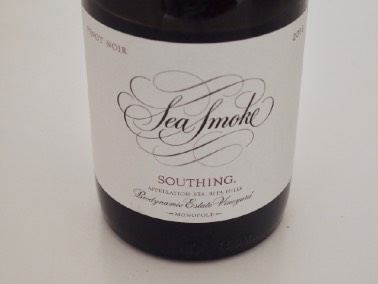 2016 Sea Smoke ‘Southing’ Sea Smoke Estate Vineyard Sta. Rita Hills Pinot Noir 14.8% alc., pH 3.45, TA 0.61, $65. Released October 2018. 100% gently de-stemmed, 5-day cold soak, inoculated with cultured yeasts, total maceration time of 14-18 days. Aged 16 months in French oak barrels, 45% new. Bottled unfined and unfiltered. · Dark garnet color in the glass. Patience is required to fully appreciate this wine. The ripe black fruit aromas are muted initially and only come to life over time. Stacked and packed with luscious blackberry, boysenberry and cassis fruit flavors framed by bold, yet well-mannered tannins. Mouth filling, yet elevated by bright acidity, finishing long with copious fruit persistence. This wine was considerably more suave and charming when re-tasted from a previously opened and re-corked bottle one and two days after opening. Decanting or further cellaring is advised. Score: 93
2016 Sea Smoke Sea Smoke Estate Vineyard Sta. Rita Hills Chardonnay 14.9% alc., pH 3.35, TA 0.63, $65. Released October 2018. Whole cluster pressed into a steel tank and cold settled. Then racked to a stainless steel fermenter and inoculated for primary fermentation. Finally, racked to French oak barrels, 26% new, and aged 16 months with periodic lees stirring. Bottled without fining or filtration. · Moderate golden yellow color in the glass. The nose offers a cornucopia of aromas including apple, citrus, pastry cream, crushed shells and a hint of flint. Richly composed, offering flavors of grilled lemon, pineapple, and toasty oak. Opulent and mouth-filling, with good alcohol integration. The texture is particularly appealing with a sleekness rather than creaminess. Spirited acidity typical of the Sta. Rita Hills infuses vigor into the luscious citrus core. Score: 93
More Wines
2016 Cobden Wini Reserve Russian River Valley Pinot Noir 14.0% alc., pH 3.68, TA 0.60, 100 cases, $75. Produced from south-facing, hillside blocks on the estate vineyard. Rich clay soils, a cool microclimate, and low yields. A four barrel selection by winemaker Mark Davis. These barrels were kept on the lees an additional 7 months (for a total of 18 months), with each barrel stirred monthly. The wine was bottled unfined and unfiltered. · Moderately dark garnet color in the glass. Leading off are aromas of black grape, black berry, prune and vanilla, with a slight bit of volatile acidity that dissipates. This is a very ripe-fruited wine offering mid weight flavors of black cherry and blackberry accompanied by underlying toasty oak. Sleek in texture, finishing smooth, long and ingratiating. When tasted the following day from a previously opened and re-corked bottle, the wine was less appealing, with a roasted fruit tone and more aggressive oak accompaniment. Score: 89
2017 Decoy Sonoma County Chardonnay 13.5% alc., 64,000 cases, $20. This label is part of the Duckhorn Wine Company portfolio. A value play that is widely available in the marketplace. Aged in 10% French oak barrels and 90% stainless steel. · Moderately light golden yellow color with a little spritz in the glass. Aromas of lemon creme, pear, forest path and maple lead to similar flavors. Light weighted, even a little shallow, with reserved oak and likable balance. An easy-to-drink, everyday quaff that does what it is asked to do. Score: 87
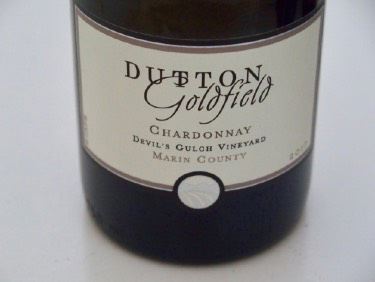 2017 Dutton-Goldfield Devil’s Gulch Vineyard Marin County Chardonnay 13.5% alc., not released, very limited. Sourced from a small block of Chardonnay planted in 1980 and farmed by Mark Pasternak. Fermented and aged on the lees in stainless steel barrels. · Pale golden yellow color in the glass. The nose will wow you will soaring aromas of golden apple, poached pear and lemon pith. Ridiculous fruit purity and energy, featuring citrus, apple and pear flavors unadorned with oak. The purest expression of Chardonnay in a very clean and crisp style with a slightly creamy mouthfeel. A very special wine of uncommon breeding that will stun Grand Cru Burgundy (Chablis) geeks. Still wonderful when tasted the following day from a previously opened and re-corked bottle. Merci! Score: 98
The Chardonnay vines at Devils Gulch Ranch in Marin County were planted in 1980 by Mark Pasternak. He believes the clone is Wente 4, but at the time he purchased the vines to plant his original vineyard, you did not ask nurseries for a specific clone. One simply specified Chardonnay. Given the age and presence of a virus on many vines, and the mostly “chicks” among the hens in the clusters, it is unlikely though it is a cleaned up version of Wente and possibly is Old Wente. The mystery is part of the attraction.The rootstock is AxR1. Yields vary from 1.5 tons to 3.5 tons per acre. Bud break is very early, sometimes in February. Because the vineyard is at the top of a ridge, and subject to maritime influences from the Pacific Ocean to the West and the San Francisco Bay to the East, the vines due not have frost pressure. The vineyard is warmer in the winter and cooler in the summer than most other vineyards except perhaps those in the Sta. Rita Hills and Santa Maria Valley. The first harvests of Chardonnay, 1986, 1987, 1988 and 1990, were all sent to Kalin Cellars for their sparkling wine. In 1990, there was too much fruit for Kalin so Mark sold a few tons to Dan Goldfield at La Crema. From then on, Dan purchased all the fruit from Devil’s Gulch Ranch until around 2000 when Mark started selling the Chardonnay to Schramsberg for their sparkling wines. Around 2010, Mark stopped selling to Schramsberg and Dan resumed purchased half and some went to Couloir and Easkoot. The 2018 Chardonnay all went to Dan at Dutton-Goldfield. For the past few years, Dutton-Goldfield has produced both still and sparkling Chardonnay from Devil’s Gulch Ranch.
2015 Ken Brown La Encantada Vineyard Sta. Rita Hills Pinot Noir 14.4% alc., pH 3.58, TA 0.60, $60. 50% 115 and 50% Swan selection. 100% de-stemmed, cold soak, aged 11 months in French oak barrels, 37% new. · Moderate garnet color in the glass. Very enticing aromas of chocolate-covered cherries and spice. Mid weight flavors of black cherry, black raspberry, toast and tobacco. Plenty of sweet fruit to delight, with finely-tuned tannins and some finishing generosity. A pleasing wine, but displays more oak seasoning than I personally prefer. Score: 92
2016 Ken Brown Sta. Rita Hills Chardonnay 13.9% alc., pH 3.37, TA 0.67, 141 cases, $38. 75% Rita’s Crown and 25% Chapel vineyards. Both vineyards are windy and cool westerly sites leading to low yields. Barrel fermented and aged on the lees in French oak barrels, 14% new, for 11 months. · Light golden yellow color in the glass. Appealing flinty aroma, with added notes of pineapple, yellow apple and buttery biscuit. Lighter weighted and elegant with flavors of pear, grilled pineapple, lemon, and blond caramel. Easy to like, with a creamy texture and welcome harmony. Score: 91
2017 Siduri Santa Barbara County Pinot Noir 14.7% alc., TA 0.65, $34, screw cap. winemaker Adam Lee’s first Santa Barbara County appellation wine. Primarily from vineyards in the Sta. Rita Hills. A mix of de-stemmed grapes and whole clusters. · Moderate garnet color in the glass. Aromas of black cherry, spice and fertile earth lead off. Silky in the mouth, with middleweight flavors of cherry, strawberry and sneaky oak. Fresh, forward and simple with a modest finish. Score: 88
2017 Siduri Russian River Valley Pinot Noir 14.5% alc., pH 3.48, TA 0.58, $35, screw cap. A blend of 12 vineyard sites. Fermented and aged separately in French oak barrels, 30% new. Married in tank after 8 months in barrel and then returned to barrels to finish aging. · Moderately dark garnet color in the glass. Enviable aromas of dark fruits, wilted rose, pepper and mulch. The mid weight core of black cherry and blackberry fruit is expansive in the mouth, holding on with vigor through the finish. Nicely composed with good harmony, a silky demeanor, and a pleasing finish. Score: 90
2015 Windvane Carneros Pinot Noir 14.5%alc., pH 3.69, TA 0.54, 1,964 cases, $45. Sourced from Windvane’s 335 acres of certified sustainable estate vineyards in Carneros.Winemaker is Steven Urberg. Clones are Pommard, Wente, Colmar, and Mt Eden. 100% de-stemmed, lightly crushed and cold soaked for 2 days. Free run juice only was transferred to French oak barrels, 46% new, for aging for 9 months. · Moderate garnet color in the glass. There is significant oak-related smoke, toast and tobacco aromas obscuring the black cherry fruit. Discretely concentrated in a mid weight style, with flavors of black cherry, cola and toast with an earthy bent. Spirited and silky with modest tannins and a cherry-filled finish. Score: 89
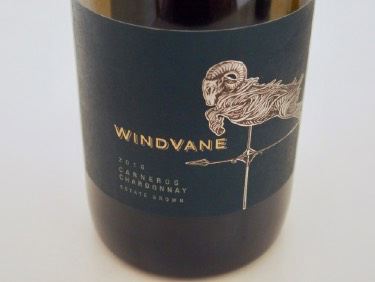 2016 Windvane Carneros Chardonnay 14.5% alc., pH 3.25, TA 0.67, 2,700 cases, $40. Clones include 96, 4, 5, and 108. Whole cluster pressed and transferred to stainless steel tanks for cold settling. The racked juice was inoculated and transferred to French oak barrels, 25% new, for 9 months of aging. About 21% of the wine underwent malolactic fermentation. Lees stirring was done during monthly toppings. · Moderate golden yellow color in the glass. Nicely perfumed with aromas of lemon oil, pineapple, buttery brioche and toast. Rich in the mouth with layers of pineapple, pear, white peach and lemon goodness. Moderately viscous on the palate. The underlying bright acidity is well-integrated as is the thread of enhancing oak. A quintessential California, sun-kissed style of Chardonnay. Score: 93
Pinot Briefs
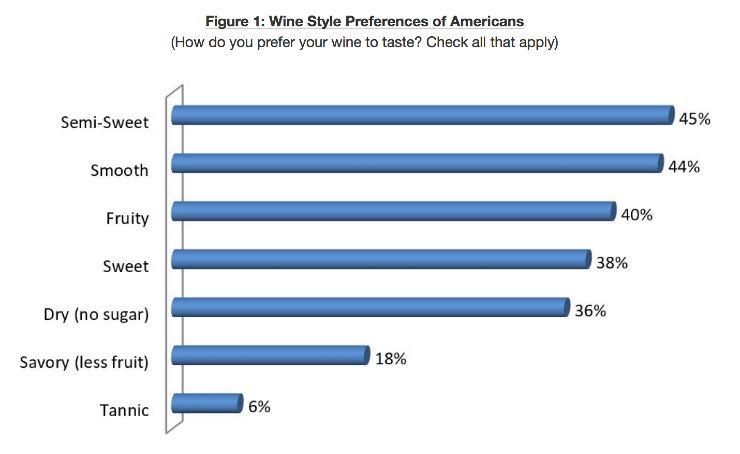 Blogger W. Blake Gray, at www.blog.wblakegray.com, recently wrote about this study and interviewed the Dr. Liz Thach MW who spoke about the American preference for sweet wines. She believes that small wineries should think about offering sweet as well as dry wines. East Coast wineries are already doing this. Remember the popularity of White Zinfandel! Another interesting outcome of this study was consumer’s habit of consuming wine soon after purchase. Very few of those polled prefer to age their wines.
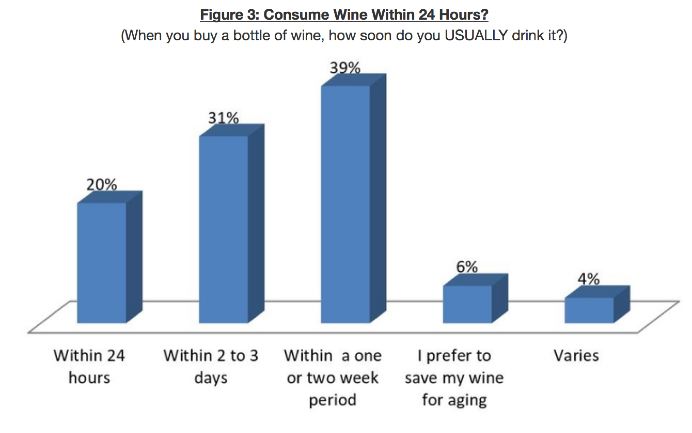 Monterey Wines Conjunctive Labeling in Effect January 1, 2019 Starting January1, 2019, all wines labeled with an AVA located entirely within Monterey County, must also include the term “Monterey County” on the label. This practice is known as conjunctive labeling in the wine industry. This type of labeling results in a greater levels of awareness of a wine region and bring more value to the local wine industry and other industries aligned with brand Monterey. Monterey County grows 7% of the wine grapes in California, cultivating approximately 46,000 acres of wine grapes (similar in size to Napa Valley’s cultivated acreage). Monterey Wine Country has nine AVAs including Arroyo Seco, Carmel Valley, Chalone, Hames Valley, Monterey, San Antonio Valley, San Bernabe, Santa Lucia Highlands and San Lucas. For more information, visit www.MontereyWines.org/labeling. Hangover Cure Book Hangover cures have been written about for centuries. Author Shaughnessy Bishop-Stall has been studying the subject of hangovers for the past decade and has published a book, Hungover: The Morning After and One Man’s Quest for the Cure. just before the 2018 holidays. He conducted considerable research and arrived at one cure that includes a combination of multiple capsules containing amino acids and vitamins after drinking and before sleep. For specifics, you will need to read the book. I don’t think a cure for a hangover is a personal necessity for me now since over the years I have come to avoid copious alcohol consumption or binge drinking. From a doctor’s point of view who has studied the effects of binge drinking, I believe it is a serious health risk. But for those that can’t resist a fling with alcohol or face the possibility of a hangover, this book may be of value to you. I can’t vouch for the book’s cure since I have never plan to have a need to try it.
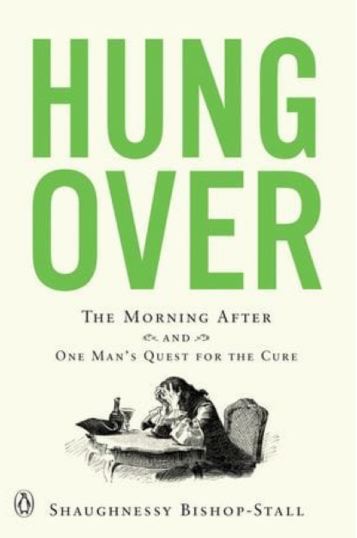 How to Best Clean Wine Stems I read recently about an effective trick to cleaning glassware at www.mymagazine.us. Those annoying smudges and water spots on your wine glasses can be cleaned using a large basket coffee filter. Splash each glass with a small amount of water and polish using the filter. The filter leaves no lint or paper residue. One can also use the coffee filter paper to remove any cork or wax particles in the wine by pouring the wine through the filter. Joseph Swan Vineyards Winemaker Dinner This special dinner honors the 50th anniversary of the legendary Joseph Swan Vineyard and will be held at John Ash Vintners Inn in Santa Rosa on Thursday, January 24, 2019. Winemaker Rod Berglund will be on hand. Eight wines have been selected by Rod and Executive Chef Tom Schmidt. Rod is celebrating his 40th vintage as a winemaker in 2018 and 31 years at the helm of Swan Vineyards. The original mother block of the Swan “clone” at Joseph Swan Vineyards was planted in 1969 and is one of the oldest producing Pinot Noir vineyards in Sonoma County. Tickets are $150 all inclusive. RSVP to rameral@vintnersinn.com.
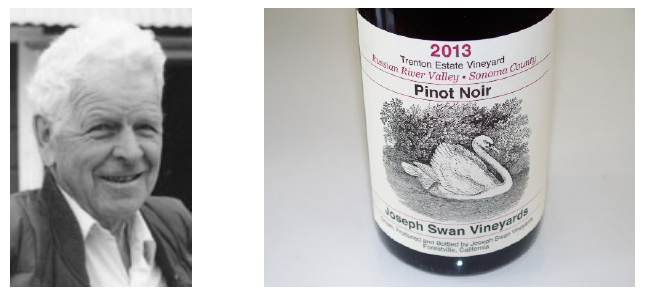 Reminder: 2019 Wine & Health Summit Physicians, wine professionals and consumers with an interest in wine and health are invited to attend on May 4-7, 2019 at UC Davis. CME credits are available for the conference. Visit www.renaudsociety.com. Father & Sons MAC Classic Gala Featuring The Wrights & The Etzels On Saturday, February 9, 2019, there will be a winemaker’s dinner under the wings of the Spruce Goose at the Evergreen Aviation Museum celebrating Oregon wine industry roots featuring winemaking fathers and sons. Honorees are Ken Wright of Ken Wright Cellars, Cody Wright of Purple Hands, Michael G. Etzel of Beaux Freres, and Mikey D. Etzel of Coattails Wines. McMinnville Wine & Food Classic’s Wine Competition Best of Show will be revealed. Tickets are $200 per seat or $1,500 for a table of 8 with all profits benefitting Children’s Education at St. James Catholic School. Visit www.macclassic.org/ mac-classic-gala.
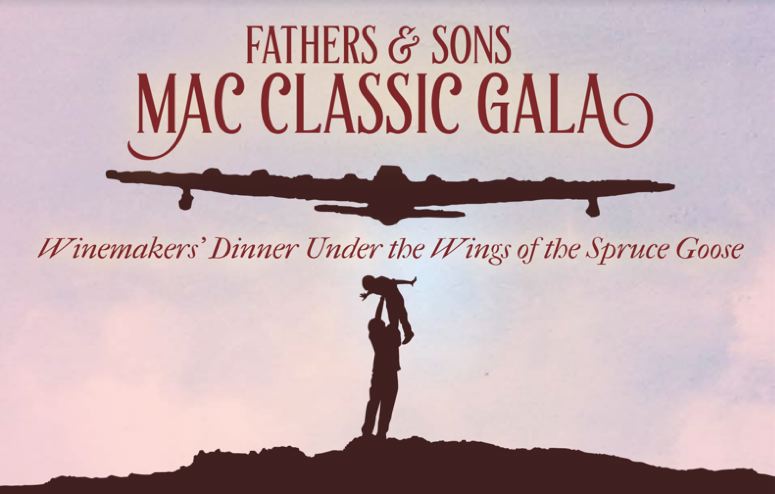 Insight Into Jackson Family Wines Shanken News Daily published Part 1 of an interview with Rick Tigner, CEO of Jackson Family Wines: www.portal.mshanken.com/ vm2/5facba1693e960a6/25682/44cd5f8e77a537ef58a5d1efeef5fa7b/25682. Jackson Family Wines now operates more than 40 wineries worldwide with a total of 6 million cases in depletions. All of the Jackson Family wineries operate independently and use their own local expertise. The Oregon lineup includes Zena Crown Vineyards, Gran Moraine, Penner-Ash and WillaKenzie, as well as La Crema and Siduri that produce some Oregon wines. the company’s McMinnville winery opened in 2018. La Crema is one of the Jackson Family’s most popular brands, expanding by nearly 70% since 2010. The Canna-Cannibalization of Wine from Lewis Purdue at Wine Industry Insight:
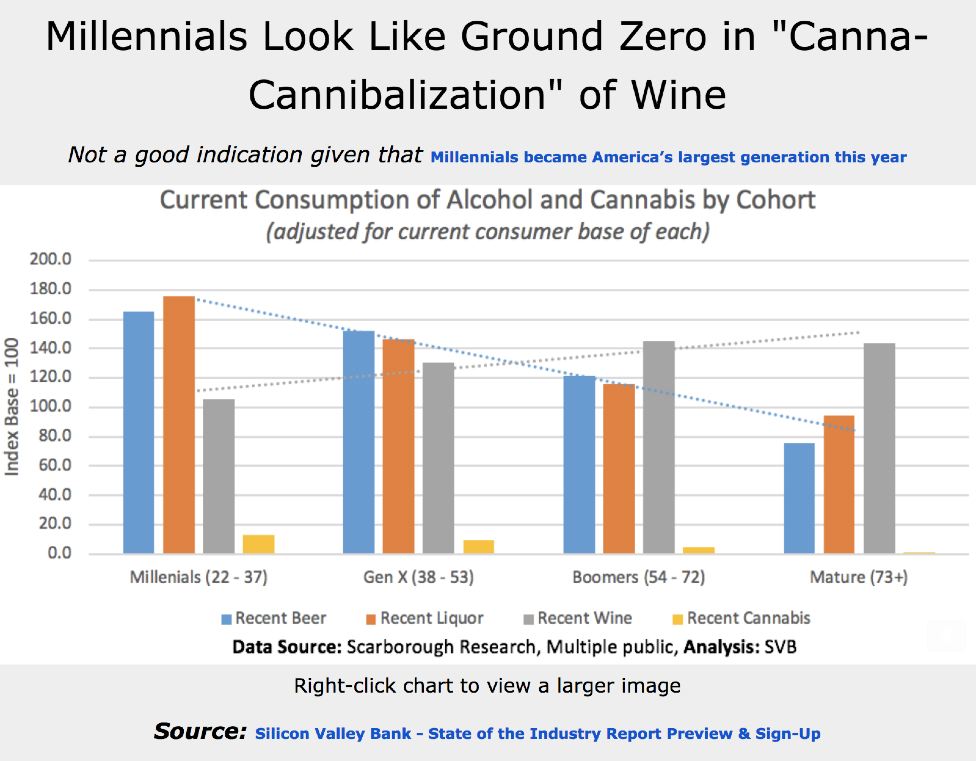 ߐ
Wine for Dummies, 7th Edition
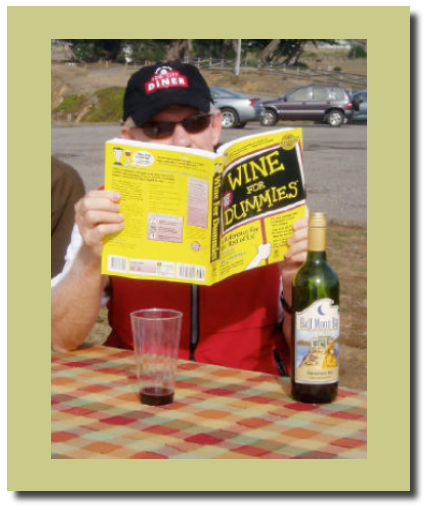 The seventh edition of this classic reference book adds new countries and regions, updated prices, new styles of popular wines and updated information on the latest vintage years. Written by wine authorities Ed McCarthy, a well-known Certified Wine Educator and Mary Ewing-Mulligan, a Master of Wine, the first edition of this easy-to-use book appeared in 1995 and has been revered for its straight talk about wine. This is not a book to read from start to finish, but rather one that can be referenced as needed on specific subjects. The information contained is very basic and is most suitable for those developing an early interest in wine and want to learn more. There was a time in my wine knowledge infancy when I had a copy of Wine for Dummies on hand (see photo above taken many years ago). Wine is such a complex subject that even a book such as this of over 400 pages cannot possibly delve into wine regions in an exhaustive fashion. For example, the section on Australia covers only four pages and nearby New Zealand only two pages (you would need to buy the Australian and New Zealand Wine for Dummies book) Although the book was recently published, it suffers from a malady suffered by many similar books in that it is not completely up to date when finally published. For example in the discussion of American Viticultural Areas, there is no mention of the now-approved Petaluma Gap AVA and the impending True (West) Sonoma Coast AVA. The soft-cover book is sold for $24.99 ($19.74 at Amazon) and the Kindle edition is $13.00. For a more comprehensive general book on wine (over 1,000 pages and more unwieldy) sold in paperback at the same price, consider the Wine Bible by Karen MacNeil. |